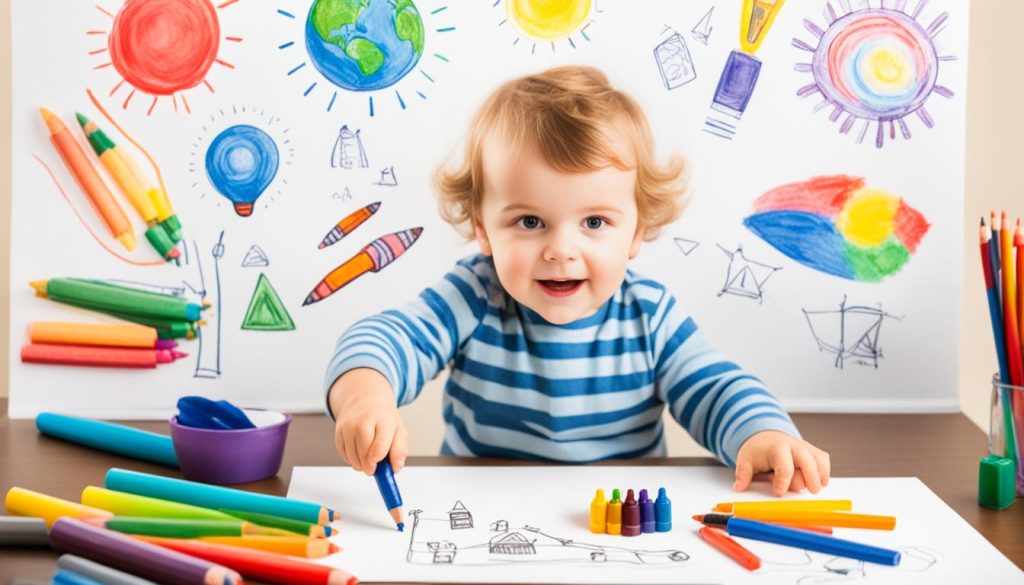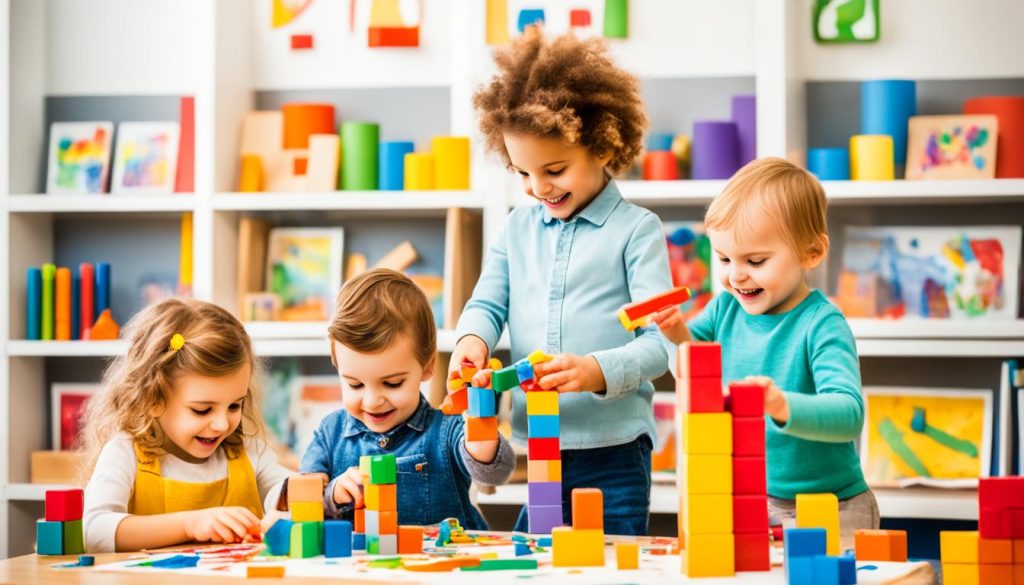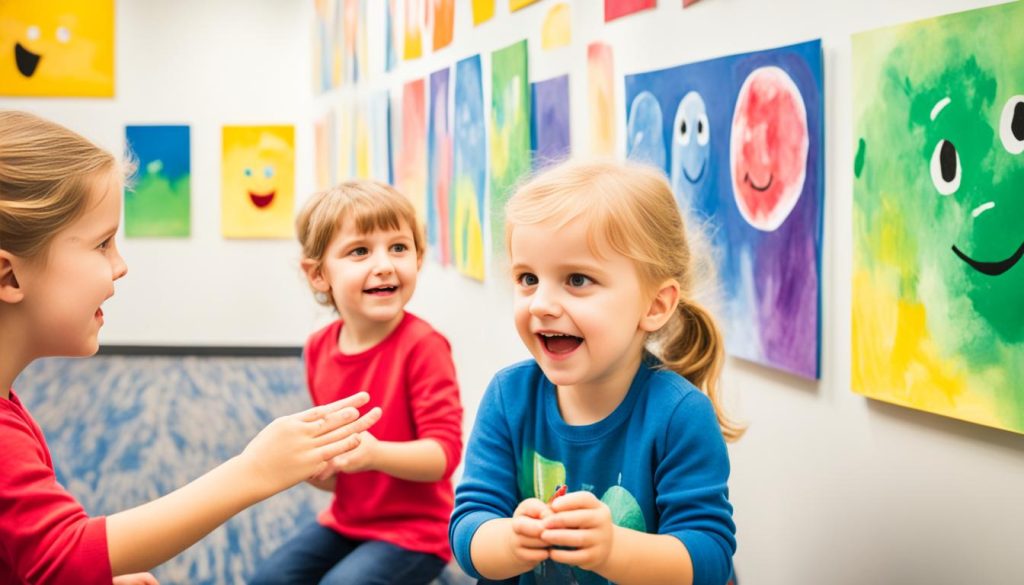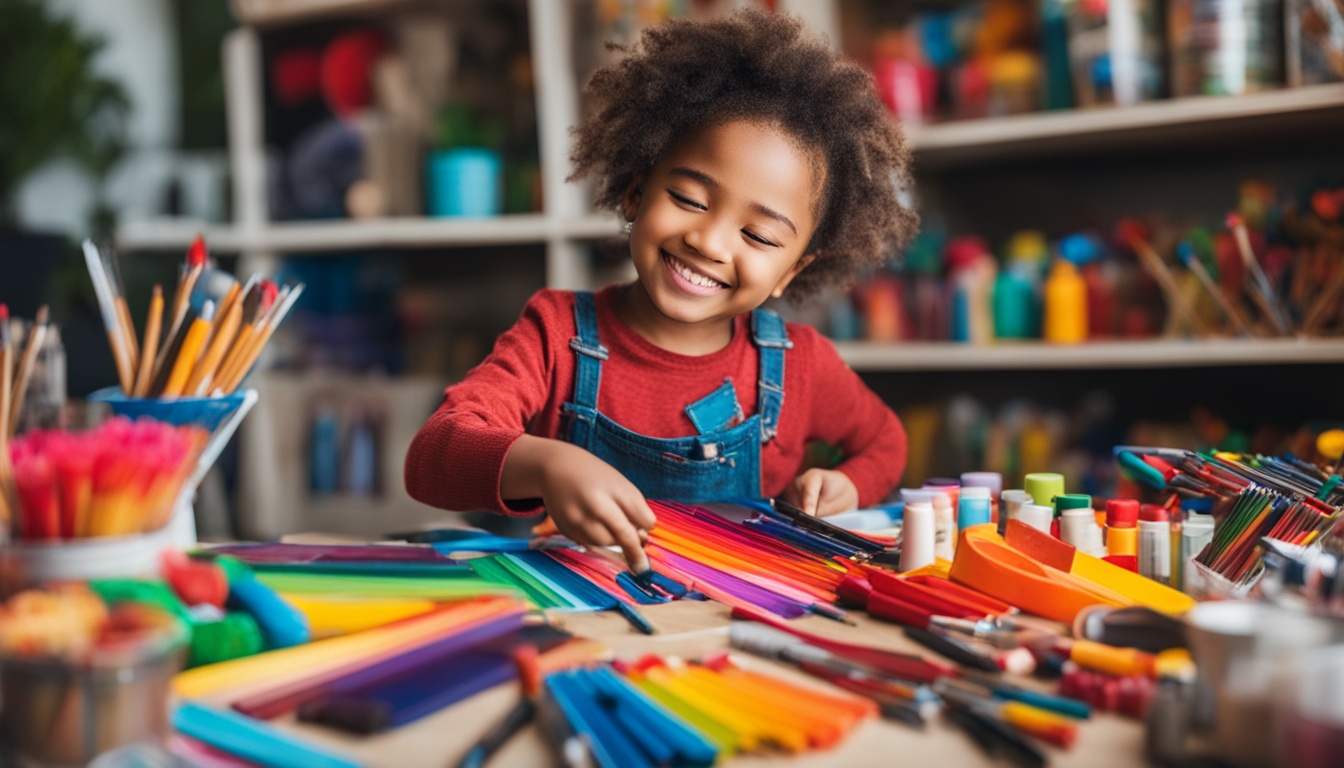Imagine a world where every child gets to explore and dream freely. This freedom sparks incredible creativity. From young ages, kids start drawing with crayons, to later solving complex problems, creativity helps them see and interact with the world. By nurturing their creativity, we help them become resilient and innovative for the future.
Research shows that exposing kids to many activities and experiences helps spot their creative strengths. Encouraging them to try new things boosts their growth and creative thinking. When they face challenges, supporting them teaches them to see mistakes as learning moments. This builds a strong base for creativity as they grow up.
In today’s world, where screens often take over, parents and teachers play a key role. By promoting creativity through play and varied materials, kids develop skills for tomorrow’s challenges. It’s not just about making the next great artist or scientist. It’s about raising people who think deeply and care about the world.
Key Takeaways
- Exposing children to diverse experiences can significantly enhance their creative strengths.
- Encouragement and perseverance in creative efforts can lead to original and innovative thinking.
- Normalizing failure as part of the creative process helps build a growth mindset in children.
- Fostering creativity aids in problem-solving and adaptability, vital skills for an unpredictable future.
- Creative activities from a young age are linked to improved academic performance and cognitive development.
Importance of Creativity in Child Development
Creativity is key in child development. It boosts mental growth and helps with sensory, verbal, and hand-eye skills. It lets kids master their world and share unique ideas, improving Child Development Milestones.
Creative play is vital for kids’ physical, mental, and social growth. It’s a big part of their development.
Creative Skills and Lifelong Benefits
Learning creative skills early has big benefits for life. For example, drawing can lower stress and improve problem-solving. It also helps kids grow a Growth Mindset for Kids, making them ready for new challenges and learning from mistakes.
This mindset is key for the changing job market and global challenges. Skills like being flexible and coming up with new ideas support lifelong learning and innovation.

Role of Creativity in Problem Solving
Encouraging kids to be creative helps them solve problems better. These skills are crucial in today’s fast-paced world. Kids who play creatively, like building with blocks or pretending, learn to think differently.
This builds resilience and adaptability, important for tackling big issues like climate change and social inequalities. Creative kids can connect different ideas to find new solutions, setting them up for success.
Groups like Art with a Heart show how creativity helps kids deal with tough times and grow emotionally. This shows creativity’s big role in emotional and mental health, not just in art.
Creating a Stimulating Environment for Creativity
Creating a stimulating environment is key for boosting creativity in kids. It blends the Role of Play in Child Development with learning, making a space that grows creativity and new ideas.

Role of Play in Creative Learning
The Role of Play in Child Development is huge for creative learning. Play boosts brain growth and helps kids think flexibly, letting them try new ideas safely. Ken Robinson’s TED talk says schools should mix more play into learning to spark creativity.
Incorporating Novel Materials
Adding new materials to classrooms boosts Creative Classroom Experiences. Using things like recycled stuff, nature, and arts supplies sparks kids’ imaginations. Research from the University of Surrey shows that making kids experiment and think deeply leads to more creative ideas.
Flexible Classroom Design
A flexible classroom is key for creativity. Spaces that change and adapt make kids feel safe to explore and take risks. With movable furniture and areas for different activities, classes become more engaging and creative.
Flexible, playful, and innovative learning spaces boost creativity in kids. For tips on talking to kids about tough topics, check out this article.
Positive Parenting for Creative Minds
Using positive parenting methods is key to boosting creativity in kids. By focusing on positive reinforcement, parents can make a supportive space for creativity. This strengthens the bond between parents and kids. Let’s look at how you can use these methods to help your child’s creative side.

Encouraging Child Creativity
Supporting your child’s hobbies is a big part of positive parenting. Giving kids many chances to try new things helps them learn and see the world differently. Let your child try out different arts like painting, music, or dance. Activities like building models or playing make them feel proud and spark creativity.
- Provide diverse opportunities – Give your child a variety of materials and activities they like.
- Celebrate achievements – Show off your child’s art at home or share it with others to make them feel proud.
- Encourage problem-solving – Let them figure out solutions on their own to boost their thinking skills.
Building Self-Esteem in Children
Helping kids feel good about themselves is key to their creative growth. Positive parenting makes kids feel important and confident. A study by Pettit, Bates, & Dodge (1997) found that supportive parents lead to better school behavior and fewer problems. Praising effort, not just results, teaches kids to keep going and bounce back from setbacks.
Also, programs like those from the Gottman Institute show that positive parenting can really help kids. Parents who use these methods see a big change in their child’s behavior. This kind of support not only makes the parent-child bond stronger but also helps the child grow in many ways.
| Statistics on Positive Parenting | Data |
|---|---|
| Parents benefiting from positive reinforcement | 90% |
| Improvement in child behavior with positive techniques | 79% |
| Increased cooperation and independence in children | 70% |
Supporting Your Child’s Emotional Intelligence
Helping your child grow emotionally is key to their happiness and health. By adding art and creativity to their day, you help them understand and control their feelings.

Emotional Expression Through Art
Art can really help your child’s mental health. It lets them show feelings they can’t yet put into words. This way, they can safely explore their emotions:
- Painting and drawing—Kids can show what they feel through art.
- Clay modeling—This lets them turn feelings into something they can touch.
- Storytelling through art—Making stories and characters helps them share their feelings.
Studies by Dr. John Gottman show that knowing and managing feelings is more important than IQ for kids. By age four, kids start to find ways to deal with feelings. Teaching them about emotions can make them more confident and well-rounded.
Creative Communication Strategies
Creative ways to talk and share feelings are key for kids. These methods help them say what they need and feel in a good way:
- Role-playing—Kids practice talking in different situations.
- Interactive storytelling—They tell stories that reflect their feelings and thoughts.
- Emotion cards and games—These tools help them recognize and share emotions.
Kids with strong creative communication skills do better in relationships and social situations. For example, kids of parents who teach them about feelings are healthier and do better in school. Studies show that controlling emotions is more important than IQ or family background for success.
| Skills | Benefits |
|---|---|
| Artistic Emotional Expression | Helps in identifying and managing emotions |
| Creative Communication Skills | Enhances social interaction and relationship-building |
| Child Mental Health Support | Improves mental well-being and emotional stability |
It’s normal for kids to feel negative emotions, and these feelings usually lessen as they get older. Using art and creativity helps your child deal with life’s ups and downs in a smart and caring way.
Effective Discipline Strategies For Creative Children
Disciplining creative kids needs a careful approach that boosts their creativity and guides their actions. Effective discipline strategies are key for keeping things in order and teaching self-discipline and responsibility. The Canadian Paediatric Society says discipline should be fair, consistent, and right for the child’s age, focusing on respect and safety.
It’s important to use methods that reward good behavior. Setting clear rules and letting kids help solve problems can teach them responsibility. These methods help manage their behavior and support their creativity. For example, talking things through and working together to find solutions are great for child behavior management.
Handling sibling rivalry is another area where these strategies work well. By creating a respectful and team-like home, kids learn to deal with conflicts well. Encouraging teamwork and respect among siblings can lessen rivalry and bring more peace to the home.
Also, setting boundaries with kids is crucial to make them know what’s expected while feeling safe and loved. Boundaries teach kids what’s acceptable, helping them develop self-discipline and a good conscience. Being consistent is important here, as being unpredictable can make kids disrespect you and weaken discipline’s impact.
Studies show that kids who are disciplined without physical punishment tend to have better mental health and self-esteem. Spanking doesn’t help in any way and might cause more behavior problems. Instead, using discipline methods that match a child’s age and personality can lead to better results.
“The foundation of effective discipline is respect, aiming to protect the child from danger, help with self-discipline, and develop a healthy conscience and internal sense of responsibility.” – Canadian Paediatric Society.
In summary, using effective discipline strategies like clear rules, positive feedback, and working together to solve problems helps manage behavior and supports creativity. These methods are also key in dealing with sibling rivalry and setting the right boundaries with kids, ensuring they grow up in a positive and supportive setting.
Parenting and Raising Kids with Creative Confidence
To help kids grow with creative confidence, it’s key to talk well and set clear rules. Using the right parent-child communication techniques makes a big difference. It helps build a space where creativity and independence grow, and building resilience in kids becomes easier.
Parent-Child Communication
Talking openly with your kids is vital for raising kind children. By using positive reinforcement parenting, you boost their creative side. About 25% of parents focus on boosting self-expression, showing its key role in making kids inventive and confident.
Good communication means more than just talking. It’s also about listening and getting what your child feels and thinks.
Setting Boundaries with Kids
Setting limits is as important as encouraging creativity. It makes a safe space for kids to explore their creativity. Positive reinforcement parenting works well here, mixing clear rules with praise for good behavior. Around 20% of parents skip harsh punishments for a kinder approach.
- Clear and Consistent Expectations: Kids do better with steady rules that show them what’s okay and what’s not in their creative play.
- Encouraging Responsibility: Creative projects teach kids to handle their tasks and time well, making them more independent.
- Acknowledging Mistakes: Learning from mistakes without blame or shame helps kids be more resilient.
Using these tips in your parenting helps your kids do well in creativity. It also teaches them important stuff like being kind, responsible, and resilient.
Teaching Responsibility Through Creative Projects
Creative projects are a great way to teach kids about responsibility. They let young minds grow creatively and learn important life skills. By working on projects, kids take charge of their work and see the effects of their actions. This helps them feel proud and responsible, which is key for becoming independent.
Studies show that kids with high self-esteem are more responsible. They keep going, admit when they’re wrong, and ask for help when needed. Kids who do creative projects often face challenges with confidence and resilience. These are key for their mental health.
It’s important to know the difference between just following orders and taking responsibility. Responsibility means doing tasks because you know they need to be done. This idea is important when making creative projects for kids.
“Over-indulged children often expect tasks to be done for them and may struggle with gratitude and appreciation,” states Jean Illsley Clark in her book How Much is Enough?.
To avoid over-indulging kids, parents can mix learning into daily life. Giving kids tasks and chores in creative projects makes them want to help out. Teaching them about personal hygiene and self-care through creative activities helps them grow into independent adults.
Making responsibility fun can make it more appealing. Role-playing helps kids understand others and take responsibility. Using technology and apps can also make learning fun and interactive.
| Parenting Strategies | Benefits |
|---|---|
| Assigning Age-Appropriate Tasks | Inspires Participation, Builds Sense of Community |
| Creative Routines for Personal Hygiene | Lifelong Skills, Independence in Children |
| Role-Playing Activities | Develops Empathy, Fosters Responsibility |
| Utilizing Educational Apps | Enhances Engagement, Interactive Learning |
| Responsibility Jar with Rewards | Emphasizes Effort, Accountability |
Getting kids involved in community service teaches them about working together and being responsible. They learn empathy and social responsibility through these experiences. These projects help kids grow in many ways, teaching them about responsibility and their overall well-being.
Managing Screen Time to Foster Creativity
Managing screen time well can boost a child’s creativity. It makes room for other fun, imaginative activities. By limiting screen time, kids get to play outside and talk with others. This is great for their creative and social skills.
Benefits of Limited Screen Time
Too much screen time can lead to bad behavior and a sense of entitlement in kids. Constantly playing games can mess with their self-control and what they value. It can also hurt their thinking skills and make them need constant fun, making it hard to focus on other activities.
Setting limits on screen time helps kids think better and find other fun things to do. Treat screen time as a reward for doing chores or homework. Use parental controls to limit internet access at certain times. This helps manage screen time well.
Alternatives to Digital Entertainment
There are many fun things kids can do instead of watching screens. Playing outside is a great way to get active and creative. Arts, reading, and hands-on play are also good alternatives.
Outdoor games and creative projects make kids think differently and play more imaginatively. Taking breaks from screens, like screen-free days, helps kids use technology in a healthier way.
- Encouraging Outdoor Play: Get your child into sports, exploring nature, or gardening to boost creativity.
- Arts and Crafts: Give them paints, clay, and paper to let their creativity shine.
- Reading: Show them different books to spark a love for stories and imagination.
- Hands-On Projects: Building models, solving puzzles, or cooking can sharpen problem-solving skills.
Using these ideas, parents can help kids grow important skills and think creatively. This all while keeping screen time in check.
The Role of Outdoor Play in Fostering Creativity
Outdoor play is key to boosting child creativity, giving kids a world to explore and dream in. It’s important for kids to play outside often to grow their creative skills. For babies, it’s a way to learn about the world, making them curious and comfortable.
Toddlers love to explore and test their skills outside. This helps them think creatively. For preschoolers, playing outside with others is crucial for learning social skills and using their imagination. School kids also gain a lot from playing freely outside, even with sports.
Nature is perfect for kids to be creative, solve problems, and think outside the box. Even bad weather can spark a child’s imagination, making every day an adventure. Playing safely but taking risks helps kids learn from mistakes and get back up again. Being in nature makes kids behave better, focus more, and helps with ADHD symptoms.
FAQ
Why is nurturing creativity in children important?
How does positive parenting foster creativity?
What are the benefits of creativity in child development?
How can play stimulate a child’s creativity?
What are some effective discipline strategies for creative children?
How can parents support children’s emotional intelligence through creativity?
Why is limiting screen time important for fostering creativity?
How does outdoor play enhance creativity in children?
What role does emotional expression through art play in a child’s development?
How can creative projects teach kids responsibility?
What are the benefits of positive reinforcement parenting for creative minds?
This post contains affiliate links. If you click on a link and make a purchase, I may earn a small commission — at no extra cost to you. Thank you for supporting this blog and helping me keep the patterns free! Read the full Affiliate Disclosure & Transparency.
